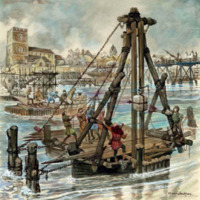Construction of the Medieval London Bridge
Item
Description
This drawing by Peter Jackson depicts the methods used to construct the first stone London Bridge in 1176. The builders created enclosures at low tide, which they then filled with debris to act as the base of each pier (visible to left in the drawing). Planks were laid across the tops of these piles, so the builders had a surface from which to construct the starlings, which were wooden-faced pilings that eased the impact of the river on the bridge's piers. In total, the bridge had nineteen arches, and nineteen piers, which supported the structures on top. The starlings required constant upkeep, made possible by the revenue generated from the many properties held by the Bridge in the city. In its over six hundred years of use, the Bridge suffered only two collapses, five arches in 1281 and two in 1437. The timber bridge visible in the background reflects the now disproven notion that the earlier timber bridge was located further east of the stone bridge.
Title
Construction of the Medieval London Bridge
Creator
Jackson, Peter
Date
c. 1970
Source
Gerhold, Dorian. London Bridge and Its Houses (Oxford, UK: Oxbow Books, 2021), Fig. 4.
Location
London Bridge
Period
eng
12th century
Image Category
eng
Modern Drawing/Painting
Image Source URL
Image Publisher
Look and Learn
Image Right Holder
Look and Learn/ Peter Jackson Collection
Subject
eng
Streets and bridges
Cataloguer
Lewis, Clare

